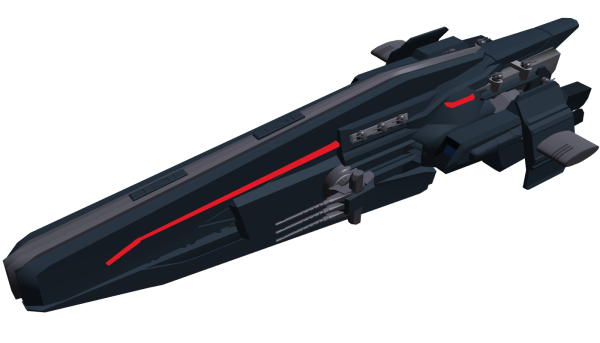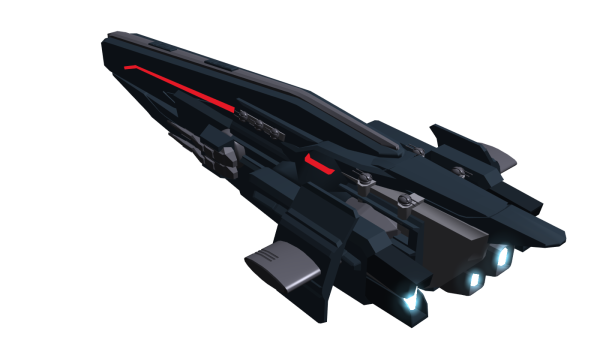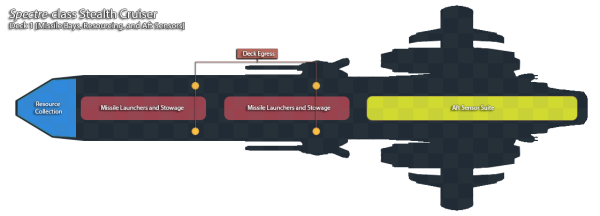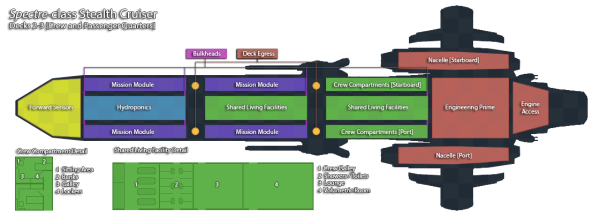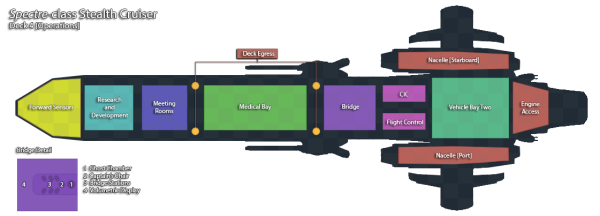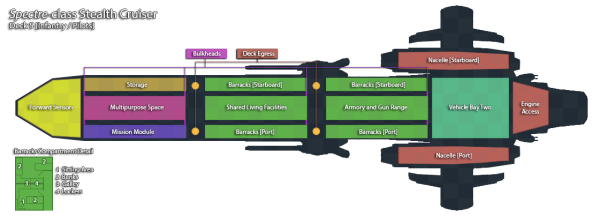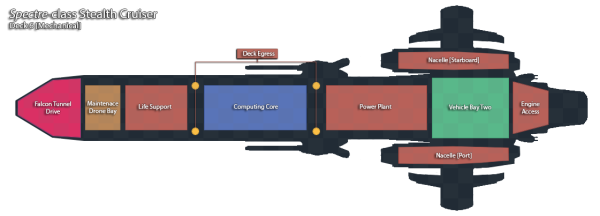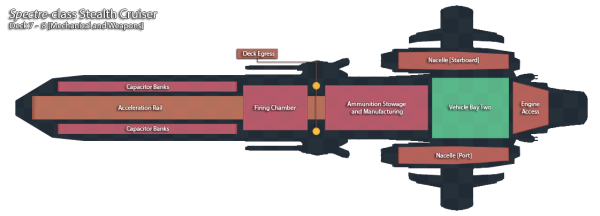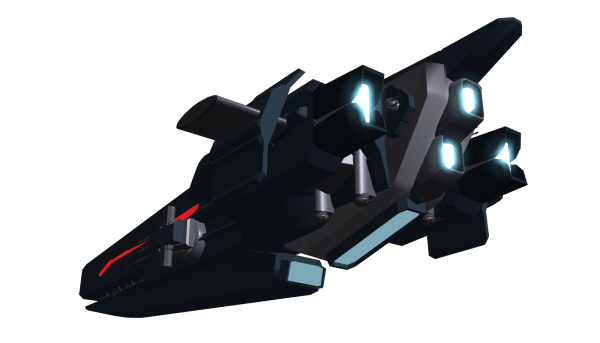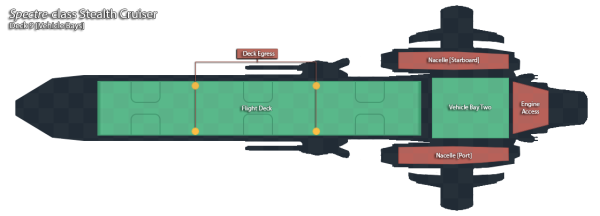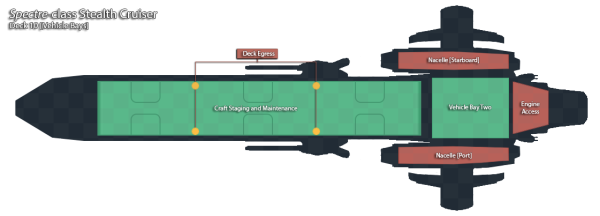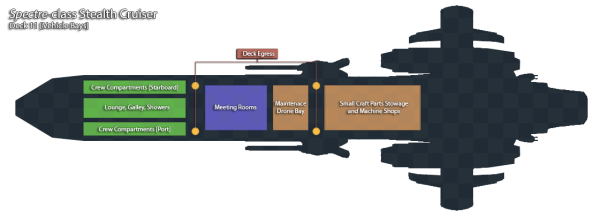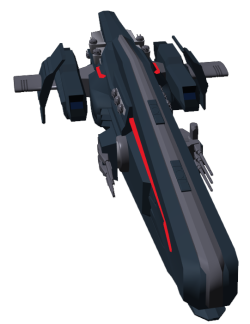Table of Contents
Spectre-class Stealth Cruiser
The Spectre is designed for independent, mission-based operation first and foremost. It features a powerful main cannon, support artillery, a variety of stealth functionality, and two vehicle bays designed to support mechanized frames.
Developed by Conclave Ship Works for the New Dusk Conclave, the cruiser first entered service in late YE 42.
About the Ship
The Spectre is a multi-role stealth cruiser designed for extended, independent operation. Its range of weaponry and capabilities make it well suited for a variety of roles, including force projection, exploration, and stealth operations.
It is the first ship built to follow the NDC's latest military policies, including the Distributed Intelligence Doctrine, and has a larger focus on mechanized frames as a primary strike force. It relies heavily on advanced artificial intelligence to automate activities traditionally performed by crew members, greatly extending the ship's operational lifetime.
Key Features
Conclave Ship Works equipped the Spectre with a robust weapons suite, including a powerful main cannon and fire support systems, large mechanized frame bays, and long-term residency quarters.
A collection of stealth devices and detection countermeasures allow it to operate largely unnoticed for extended periods of time. The first sign enemies often have of the Spectre's presence is the impact of its main cannon's shell striking their hull.
Mission Specialization
The Spectre is a multi-mission, anti-starship strike combatant with robust stealth capabilities. It can act as fleet support or operate independently.
It is intended to operate for up to three years at a time without support.
Appearance
The Spectre's body is long and narrow, with prominent nacelles that sit near the body on either side of the vessel's rear. On each side of the ship's midsection are two large turrets. The bottom of the ship features two separate Chromatic Bay Entrances for deploying fighters and mechanized frames.
History and Background
In the years of the Kuvexian War, the New Dusk Conclave found itself in a difficult position. Vastly outgunned by its allies and potential enemies, the faction needed a way to contribute against aggressors in the sector without having to contribute a significant portion of their system defense forces.
While the new ship would need to fill a similar role as the legendary gunships fielded by Yamatai and Nepleslia, it would need to take a different approach to combat if it were to achieve similar results with a comparably smaller 'population'. Covert strikes and force deployments would be key to the ship's success.
Accordingly, the new ship was equipped with a range of the NDC's best stealth technology and weaponry considerably less flashy than its counterparts in the other factions. To facilitate the NDC's preference for frame combat, the ship was expanded beyond the normal gunship profile into that of a cruiser to accommodate additional craft.
Statistics and Performance
While fast for a ship of its size, it is the Spectre's advanced stealth and targeting systems that define its operational capabilities. For extended sorties, it carries a large compliment of mechanized frames to expand its threat area.
General
- Class: CSW-C3-1A
- Type: Cruiser
- Designers: Conclave Ship Works, in conjunction with D.O.A.R.A.D.
- Manufacturer: Conclave Ship Works
- Fielded by: New Dusk Conclave
Passengers
Minimum Crew: 5 Operators or skilled Geist-users are required. In non-combat situations, a single Operator can control the ship at a reduced level of functionality.
- 1 Captain
- 2 Ghosts
- 2 Engineers
Recommend Crew: 13
- 1 Captain
- 2 Ghosts
- 2 Pilots, supplemental
- 2 Weapons Directors, supplemental
- 4 Technicians
- 2 Corspman
Supplemental AI Crew: 7, plus 40 drones
- 1 XO - Destiny "KING" AI
- 1 Communication Officer - EVE
- 1 Logistics Officer - EVE
- 1 Information Technology Officer - EVE
- 2 Corpsman - EVE
- 1 Attendant - EVE
Infantry and Fighter/Frame Pilots (Standard Compliment of 160, Accommodations for up to 240)
- 40 Pilots
- 120 Infantry
Maximum Capacity: There are accommodations for up to 320 people, not including Supplemental AI Crew. About 400 people can fit aboard in an emergency, but the ship would be extremely cramped. Much of this capacity is sealed off while not in use. Additional crew or passenger space can be acquired by way of Mission Modules.
Dimensions
- Length: 390 meters (1,280 feet)
- Width:
- Main Body: 44 meters (144 feet)
- Main Body w/ Nacelles: 138 meters (452 feet)
- Height: 97.5 meters (319 feet)
- Decks: 11 (4 meters each per standard deck, with 1 meter of mechanical space between)
Propulsion and Range
- Falcon Tunnel Drive: 0.2 ly/m
- Hyperspace Fold Drive: 0.6 ly/m
- Sublight Engines: .385c
- Range: Theoretically unlimited
- Lifespan: Designed for a 15 year operational window before requiring significant refits
- Refit Cycle: Regular refits are suggested every three years, with a safe maximum of seven years
Damage Capacity
- DRv3 Tier: 12 (Heavy Anti-Starship)
Inside the Ship
The Spectre's interior is a matte assortment of flat whites, grays, and blacks, with occasional red or gold trim. It features little in the way of navigation assistance or decorative elements. A non-augmented passenger might find the ship difficult to navigate or bland.
An Operator or Geist-equipped crewmember, however, sees a wide range of navigational elements, decorative accents, diagnostic information, and more displayed in their vision by way of their HUD in an Augmented Reality fashion. The specifics of what each crewmember sees varies from individual to individual based on their preferences.
Deck Layout
As the Spectre-class has a small crew compliment, the majority of its deck space either goes unused or is used for mechanical purposes. The majority of the ship's crew activity is centered around the middle decks, weapons systems, and the frame bays.
Maintenance and Modification
The majority of each deck is comprised of a variety of large, function-specific modules. These modules slide into place from the exterior of the ship alongside automated guide rails. Once all modules are in place, the floors close to conceal these rails. Integrated power and supply systems then connect to the module.
During extended maintenance periods, much of the Spectre's forward plating can be easily removed to give access to the decks within. This makes it a simple matter to remove entire deck modules and replace them with new ones. Some sections of the plating can retract during normal operation to allow for easy loading of cargo and module swaps, particularly for those modules designed to be replaced on a mission-by-mission basis.
The majority of ship maintenance is handled by small, semi-autonomous drones. These drones easily travel through corridors between decks and emerge from floor or ceiling panels at their destination.
Deck 1 : Missile Bays and Mechanical Space
The top deck holds the ship's primary missile launchers, ammo for those launchers, and a large sensor suite used for adjusting the ship's stealth functions.
A large resourcing area sits at the front of this deck, housing eight large MultiStruct Multitools and supporting infrastructure. This allows the ship to replenish its resource stores by harvesting asteroids, wrecks, and other spaceborne mineral 'deposits'. These resources are typically used for fabricating new parts and ammunition.
Resources are transferred swiftly to fabrication centers across the ship via gravimetric tubing that runs between decks.
The large sensor suite towards the rear of the deck handles much of the ship's stealth management and detection. It is also where the ship's periscope is located.
Decks 2-3 : Crew and Passenger Quarters
The next decks are used to house the ship's operational crew and any passengers beyond the standard compliment. Each deck features a number of modest two occupant cabins, lounges, galleys, and shared toilet/showering facilities. These decks are designed to allow for easy downward travel to the primary decks at any time.
A variety of Mission Modules are available, outlined here.
Maximum Occupancy
- 160 Crew Members (40 Crew per Crew Compartment Module, 4 Modules Total)
Crew Compartments
The residential decks contain sixty crew compartments in blocks of ten. Interior crew cabins are double-occupancy and are 6.7 meters by 6.4 meters. Exterior crew cabins are somewhat larger, but are still designed for two occupants. Officer cabins are single-occupancy and are 6.7 meters by 13 meters.
Each cabin contains a set of lockers, a small galley, a sitting/work area, and a set of double beds that can be opened in a chest-like fashion. The accommodations are spacious for a ship of its type, but not luxurious.
Hydroponics
A large hydroponics area sits to the fore of Decks 2 and 3. Each of the hydroponics bays are able to produce sufficient food to keep the crew reasonably well fed. In addition to eating the fruits and vegetables as-is, food fabricators in the ship's galleys are able to convert harvested plants into a variety of derivatives. These include sauces, convincing meat alternatives, and various beverages.
It is primarily managed by automated systems.
Shared Living Facility
Each 'residential' deck has three areas called 'Shared Living Facilities'. These facilities take care of all of the crew's necessities not related to sleep.
In addition to the small galleys found in each crew compartment, each Facility has a large galley and mess hall area. The galley can fabricate a large variety of food and drink upon request. For non-organic crew, various synthetic supplements can be dispensed or mixed into the usual fare.
A communal washroom can support up to 12 crew at once in reasonable privacy. Each shower has its own locker space for stowing clothes while the occupant cleans themselves. The showers also double as bathrooms. Toilets and sinks can be pulled from the walls in a drawer-like fashion when needed, then stowed.
Each lounge tends to be configured to match its usual occupants. Essentially a second volumetric room with a lower 'refresh rate', the lounge can take on a variety of appearances and purposes to suit its users. The default lounge appearance is a casual, modestly lit bar area with a relaxing atmosphere. Some occupants prefer to use their lounge as a workout space, for viewing movies, or for various leisure games.
Lastly, each Facility houses a Volumetric Room. Lacking the hard light technology of other factions, the Spectre uses a combination of Rebinder, gravimetrics, and volumetric projectors to create a convincing, interactive environment. The volumetric room can be used to recreate any number of experiences ranging from a calm afternoon walk in the woods to a full-scale combat simulation for infantry or pilots.
Deck 4 : Operations
Bridge
The Spectre's bridge is an ARCO-S system. The ARCO makes the bridge highly configurable based on the occupant's preferences by dynamically forming control surfaces, seats, and more. As more bridge crew enter the room, stations based on their role automatically form up from the floor in their preferred location.
A typical bridge layout features a CSW-C3-C2 Ghost Chamber at the rear of the room for the ship's Operator. An Operator can step inside and be comfortably suspended within the chamber. Once suspended, the Operator links into the ship via the Anima System and takes control of most ship operations.
Sternward from the Ghost Chamber is the Captain's chair. Arrayed to either side of the Captain's chair are the other bridge stations.
The majority of the bridge's space remains unused by occupants during normal activity. Volumetric projectors make the bridge 'platform' appear to float in space while in use, with the view changing based on the Captain's commands. This allows the crew to easily view their location in a system, how it relates to their opponents or planetary bodies, and so on. Sections of the volumetric display can show different areas, such as zooming in on one area while keeping the overall display at system scale.
Stable gravimetrics allow crew to move within the volumetric display as though they're in Zero-G, should they desire. Both the control chamber and the zero-G space within the bridge's volumetric display are largely protected from interference from outside sources, including kinetic impacts against the ship.
Combat Information Center (CIC)
The CIC room processes information for command and control of the ship's current area of operations. It can be staffed by a crew of four or left entirely to it's extremely sophisticated Machine Intelligence system. The CIC organizes, evaluates, weights, and arranges1) information in order to make it easier for bridge crew to make excellent decisions in a swift manner.
Flight Control
Flight Control is an ARCO-S room designed to direct and support the Spectre's fighter and frame compliment. As with the CIC, it possesses a sophisticated Machine Intelligence system that rapidly updates pilots on battlefield conditions, mission objectives, and other critical information. Up to four crew members can facilitate the MI's operation at a time, providing areas of focus, updating tactics, and changing mission parameters as necessary.
The Flight Control MI is also responsible for all automated flight guidance. The majority of craft landing and takeoff operations are handled by the MI, greatly improving the efficiency and safety of the process. It also provides backup support the ship's Ghost or pilot, such as automated navigation and FTL calculations.
Meeting Rooms
A mundane set of meeting rooms, typically used for debriefings and planning sessions. Walls can be retracted or deployed from the walls via voice command to make one large room or up to ten smaller ones.
Medical Bay
A sophisticated medical facility capable of serving the needs of organic and non-organic crew alike. Features traditional spaces for triage and surgery, as well as thirty D.O.M.S. Auto-Docs for patients who do not require the individual attention of the ship's medic/s.
As with much of the ship, the majority of the Medical Bay's functionality is automated. The Medic is responsible for guiding the various artificial intelligences in the room and rarely needs to become hands-on.
Research and Development
To the front of the deck is the expansive Research & Development room. Its basic functionality matches that of the Volumetric Rooms in the residential decks, allowing occupants to simulate much of their research in the open air or divide the room up into separate workspaces.
The R&D room is equipped with sufficient investigation and fabrication equipment to be able to analyze the majority of things the crew might encounter. It can also be used for customizing existing equipment or prototyping new equipment using a 5m x 5m Daedalus Fabrication Module to better suit the mission's objectives.
In the event that an object is too large or unsafe to be moved through the crew doors, a set of concealed Chromatic Bay can be revealed on either side of the room with access to space outside. These bays are normally covered by a retractable section of the ship's bulkhead when not in use.
Deck 5 : Infantry and Pilot Quarters
Deck 5 is similar to Decks 2 and 3, with expanded crew capacity to support the ship's infantry and pilots.
Maximum Occupancy
- 240 Infantry and Pilots (60 Crew per Crew Compartment Module, 4 Modules Total)
Armory and Gun Range
The ship's Armory contains the majority of the vessel's Power Armor and personal weapons compliment, as well as tools to maintain and repair them. A Gun Range is attached to each Armory. The Ranges have powerful shields and supplemental armor to prevent any damage to the ship from weapons practice.
The Armory contains 120 Power Armors, plus their gear and sufficient maintenance equipment to support them. Heavy Power Armors, such as the BW-XA-1a E.A.S.E., are too large to fit within this module and are typically loaded in Vehicle Bay Two.
Barracks
Barracks Compartments are largely the same in layout as the Crew Compartments from Decks 2 and 3. One notable difference is that the exterior compartment has had a portion of its galley and sitting room replaced with an additional set of bunks, increasing that cabin's occupancy by 2. This increases the total capacity of each Barracks Module from forty to sixty occupants.
Typically, the interior cabins are used for officers and pilots, while the exterior cabins are used for infantry.
Mission Module
One of the ship's configurable Mission Modules is on Deck 5. An Armory module is typically used for missions where the ship has a larger than usual compliment of infantry.
Multipurpose Space
A highly configurable space that can be divided up in a number of ways by repositioning its interior walls. Can be configured to act as an exercise space, additional meeting rooms, communal crew quarters, and more.
Deck 6 : Mechanical
Deck 6 is the ship's primary mechanical deck. It contains the bulk of the ship's maintenance drone infrastructure, life support, the ship's computing core, and the massive aetheric power plant that drives the ship's internal systems, engines, and weapons systems.
Falcon Tunnel Drive
A small-scale Falcon Tunnel Drive is located at the fore of Deck 5. While capable of providing the Spectre with FTL capabilities given sufficient charge time, its primary purpose is to create a small wormhole in front of the ship's main gun, the HAVOC, to allow the ship to fire upon enemies from unexpected angles.
Given the ship's large power supply and the relatively small size of the worm holes produced, the Spectre can generate a wormhole of the appropriate size for its main gun once per minute. Worm holes are unable to be created within system, despite the ship's additional power.
While in use, a set of four gate spires extend from the front of the ship. They are appropriately shielded and reinforced to allow for safe use while the main gun is operational.
Only relatively short-range attacks using the Falcon Tunnel are possible. Any attempt to send a projectile through a wormhole that travels more than 100 million kilometers invariably results in a loss of the projectile due to conditions within the wormhole itself.
Power Plant
The Spectre's main gun and stealth system have significant power requirements. To meet these needs, the ship has a robust power generation system that takes up nearly 21,000 cubic meters of the ship's internal space across two decks.
Primary power generation is provided by a large aether generator. It is large enough to provide stable power to the entire ship on its own. Supplemental power generation is provided by a bank of four capital-ship class hyperspace taps, each also able to power the entire ship on their own. During normal operations, each generator runs at 20% capacity or less. While the main gun is active, the generators run at a higher capacity to ensure that there is no disruption of power to the ship or the ship's HAVOC cannon.
Decks 7-8 : Main Gun
Decks 7-8 are primarily mechanical decks, supporting the ship's main gun, small fabrication areas, life support, and other primary systems.
The majority of activity within these decks are completely automated, including maintenance and repair.
Vehicle Bays
The Spectre has two large Vehicle Bays, one focused on the rapid launch of fighter-form craft and the other for humanoid frames or armors.
Entrance and exit into either Vehicle Bay requires a craft to pass through a Chromatic Bay Door. Often referred to as 'the Chromie' by crew, the Chromatic Bay Door is a semi-transparent energy field that acts as airlock and shield for the Bay. It allows craft to easily come and go, without sacrificing the interior's atmosphere or safety.
The 'Chromie' is typically a soft blue color to make it easier for pilots to spot. During combat operations, it changes to a matte black.
Deck 9 : Vehicle Bay One / Flight Deck
The uppermost deck of the forward Vehicle Bay is the 'flight deck' where craft are prepared for launch. Gravimetric launchers are used to swiftly lift and jettison craft rearwards, well within the Spectre's stealth signature. This launcher system requires no deck space to operate, significantly improving the quantity of craft that can be carried by the cruiser.
Six large elevators, each big enough to fit two standard fighters or fighter-form frames, allow craft to move between the flight deck and staging deck with ease.
Deck 10 : Vehicle Bay One / Staging
The next deck is a staging area for additional craft. Here, crafts are maintained and equipped for sorties. As the flight deck empties, craft from this level are moved up on elevators.
Vehicle Bay One's Chromatic Hangar is tall enough to allow access into and out of Deck 10. Larger craft that do not benefit from the primary flight deck's launching mechanism, such as the BW-TC-1A Hellcat-class Tactical Dropship, are often deployed from this deck when the situation calls for it.
Deck 11 : Vehicle Bay One / Support
The lowest deck is for crew support and storage. Flight crews can find short-term sleeping accommodations, lounges, and a galley on this deck. Ammunition, fuel, and other necessities are stored in the remainder of the space. They can be easily called up to the staging deck at any time.
Aft : Engineering Primary
Spanning the top four decks at the ship's rear, Engineering Primary features a large Daedealus fabrication area designed for repair and construction of the ship's frame and fighter compliment. Significant resource stores and automated manufacturing systems take up the majority of the 40m by 50m space.
Aft : Vehicle Bay Two
Spanning decks five through eight, Vehicle Bay Two is built for armors and frames that don't fit the fighter form factor. Multiple levels of adjustable frame harnesses take up the interior of this bay. When the time comes to launch these frames, their harnesses extend forwards and then launch them downwards through the large, open central column. Many pilots refer to this as “the plunge”. Each level can be launched all at once.
Docking and launching frames in this fashion is handled entirely by automated systems to ensure that no frames crash into each other. This also drastically reduces the amount of time required to “re-rack” the frames after a sortie is complete.
As with Vehicle Bay Two, a deck is reserved for crew functions and storage.
Owing to its position directly beneath Engineering Primary, the central column sees a modest amount of traffic as components are moved to and from either Bay or to wherever else they might be needed within the ship.
Deck Egress
Movement between the fore decks is primarily by way of four Egress tubes. Each tube is approximately 7 meters in diameter. The rear tubes span the full height of the ship's crew accessible areas. The forward tubes span from Decks 1 through 6 and Decks 9 through 11.
The interior of each tube is entirely open, with open access ways into the nearby hallways. Non-obtrusive handles line the tube's interior. Direction arrows on either side of the tube indicate which direction that side of the tube is currently traveling. Once inside the tube, occupants are gently moved via gravimetrics in the appropriate direction. Simple green/red indicators let crew know when a tube can be entered without bumping into another crew member. The tube's spacious interior allows multiple crew to enter and exit simultaneously.
While the overall speed of traffic within the tube tends to be constant, adjustments are made on a person-by-person basis to make it safer to enter and exit the tubes. During normal operation, it takes 5 seconds to travel the height of each deck. During emergencies the tubes can reduce this speed to less than 1 second per deck with gradual deceleration near the appropriate deck.
The specific direction a tube will send an occupant varies on the time of day and current ship activities. Typically, the left side of a tube is the 'down' direction and the right side is the 'up' direction. This allows crew who miss their deck to simply change sides using the tube's interior handles and begin travel in the opposite direction. During heavy traffic periods or combat situations, the tubes may switch to travel in a single direction to improve flow and response time.
In the event that the ship loses power entirely, the handles inside the Egress tubes are placed such that they can double as ladders or Zero-G maneuver assists.
Escape Pods
The exterior walls of Decks 4 and 6 feature rows of escape pods hidden within the wall panels. Additionally, each crew compartment can be completely sealed and features a modest life support system similar to that in the escape pods.
Mission Modules
It may be necessary to bring additional capabilities in order to complete mission objectives. With that in mind, the Spectre has been designed to support eight, easily-swappable mission modules located on Decks 2 and 3. Each module is 70 meters by 13 meters.
Armory Module
A Power Armor bay capable of holding 65 power armors, their equipment, and standard maintenance services. It is possible to retract a portion of the outer bulkhead and deploy directly from this module.
Crew Compartment Module
The same crew compartment module that is usually found on these decks. Each module has either 20 standard crew quarters or 10 expanded officer's quarters.
Electronic Warfare Module
Significantly expands the Spectre's EW capabilities, including computer system penetration, signal decryption, security counter-measures, improved sensor jamming (RADAR/Mass/Distortion/Quantum/Tachyon/etc), and subtly modifying the ship's shield signature to create radar 'ghosts' to throw off incoming missiles. Most of these improvements come in the form of additional, dedicated processing power for the ship's primary EW systems.
Hospital Module
Adds an additional 20 Auto-Doc units, fabrication and repair facilities for Synthetics, surgery rooms, and 10 recovery quarters.
Research Module
Adds an additional Research and Development module, similar in capability to the primary R&D module found on Deck 4.
Sensors Module
Additional processing capacity and detection systems greatly improves the Spectre's sensor fidelity and range.
Storage Module
Simple container for carrying cargo and goods long-term. May be temperature controlled. The loading, unloading, and inventory of the module is handled automatically by a variety of built-in mechanisms.
Ship Systems
Armored Hull and Hull Integrated Systems
Each plate of the ship's armor is comprised of four layers, striking a balance between stealth functionality and resilience to attack. The first layer is Madite-C, which passively negates electromagnetic signals such as RADAR and other forms of active detection. The next layer is Madite-M-reinforced Osmanium, providing the majority of the plate's damage mitigation capability. The third layer is an anti-particle mesh that prevents stray stellar particles and exotic attacks from penetrating to the inner hull.
The final layer is Zanarium, which greatly enhances the ship's stealth capabilities when supplied with power. This stealth, however, requires a significant energy expenditure and typically requires the Spectre to lower its shields or deactivate its weapon systems. The Zanarium-based stealth system should not be operated simultaneously with the Ancile's Gravitic Shroud.
These plates are painted with Sensory Smart Coating and allow the Spectre to shift the color of its exterior so that it can conceal itself against the backdrop of space or a nearby planet.
The ship's frame is comprised of Madite-M reinforced Osmanium. The majority of interior compartments are constructed from Madite-S, making them light, durable, and capable of self-repair.
Computers and Electronics
A Destiny AI 'King' System is the primary computing and sensor system of the Spectre. All other automated systems onboard the ship are managed by it.
A bank of six EVE AI Cores are located alongside the Destiny core, providing supplemental support.
All seven of the AIs can manifest themselves throughout the ship by using pervasive volumetric projectors. The King AI avatar frequently acts as a First Mate or XO, while the EVEs handle logistics, communications, and maintenance oversight.
Possession
All onboard systems are designed to be subordinate to a primary “Ghost” in the bridge's Ghost chamber. This individual, typically an Operator, has full command of the majority of ship systems while directly connected to the ship's computer network. This is done via Anima System, effectively making the entire ship the Ghost's body. A complex interaction between non-sentient Artificial Intelligences, the King AI, and the EVE AIs translate the Ghost's will into actions across the entire ship, including weapons operation, craft deployment, navigation, and more.
This system is one key method by which the Spectre has significantly reduced its crew requirements. Actions that previously took one or more individuals to complete are essentially automated, requiring only periodic attention on the Ghost's part.
Despite the Ghost's capability to manage all ship systems in this fashion, early trials have shown that leveraging additional bridge crew improves the ship's combat effectiveness. For this reason, many crews opt to delegate major responsibilities to other bridge crew, such as a pilot, weapons officer, or science officer.
While Operators can remain active for long periods, it is common to have at least two Ghosts on a day/night shift in this role.
Automation
Significant portions of the Spectre are automated. Nearly every task that doesn't require active, sentient decision making is handled by highly sophisticated Machine Intelligences. These MIs can take direction from the ship's various AIs or Possessor. They are capable of skillfully handling all but the most unusual of circumstances without intervention, though crew may wish to provide direction to better suit their personal tastes or needs.
General maintenance, repair, and cleanliness is managed by a minimum of forty drones. These drones are able to handle the majority of issues that the Spectre may run into and ensure its ability to remain at peak operational effectiveness for many years.
Sensor Periscope
A small portion of the ship's Ancile Shield System can be disabled to allow for a three-meter tall sensor tower to raise outside of the shield's area of effect. Combined with the Gravitic Shroud function of the Ancile, this allows the ship to observe normal space while still concealed within the Shroud. The Periscope itself is not stealth capable, but it's small size renders it largely unnoticeable.
Emergency Systems
The Spectre is equipped to handle a variety of emergency scenarios.
All interior modules can seal themselves against vacuum, fire, and/or airborne contaminants. They possess modest life support and power supply systems that are capable of sustaining each module for a minimum of 3 days. The space between most modules can be sealed by way of bulkhead in an emergency. Egress tubes can seal on a deck-by-deck basis.
The ship's walls and floors reveal concealed handholds if the ship's internal gravity is lost or deactivated.
In a catastrophic failure event, sufficient escape pods are available on the outer walls of Decks 4 and 6 to support the entire crew. Crew compartments can double as escape pods in an emergency, though they lack the landing, communication, and navigation capabilities of a dedicated escape pod.
Life Support Systems
Although much of the Spectre's crew is non-organic, it nonetheless features a robust life support system. Dozens of small life support units, each featuring air and water reclamation and recycling features, sit between each deck. These systems are centrally monitored for contaminants, mechanical failures, and air/water quality issues. The ship's bevy of drones are able to quickly access any life support system that requires attention.
The various systems do not rely on disposable media or moving parts for their operation. Carefully designed, self-cleaning membranes, subtle gravimetrics, and other components greatly reduce the life support system's risk of mechanical failure and maintenance upkeep.
Under normal operations, it is expected that the life support systems can safely support the ship's crew without outside intervention for a minimum of fifteen years.
Propulsion
Four large Vortex Plasma Thrusters provide much of the ship's thrust, giving it an impressive top speed. Their drive signature is significantly smaller than that of a similarly-sized aether drive, while providing similar propulsion capabilities. Two of these thrusters are located in nacelles located near the hull on either side of the Spectre. The remaining two are stacked vertically at the aft end of the ship's main body.
Gravimetric drives act as secondary sources of thrust and provide near-planet hovering capability. Small maneuverability thrusters line the ship's hull for precision orientation.
Shield Systems
A Tier 12 CSW-S1-S1 "Ancile" Multi-Layer Shield System provides protection against a wide range of threats and bolsters the ship's stealth capabilities.
Stealth Capabilities
The Spectre derives its stealth capabilities from three different sources.
The first source is the hull's Madite-C coating, which passively dissipates a significant amount of detection signals. It also provides modest protection against systems that can detect energy signatures within the ship, but has no benefits in regard to hiding propulsion trails, weapon signatures, or mass.
The second source is a layer of Zanarium, also found on the ship's hull. This active stealth system is able to conceal the Spectre from the majority of detection systems, but cannot be used at the same time as the ship's shields due to interference and power draw.
The third and final source is from the ship's Ancile Shield System's Gravitic Shroud. The Shroud can encompass part or all of the ship in an extremely dense gravity region that bends light, mass, and signals around itself. When fully encased, the ship is completely blind and cannot adjust its course. To help with this somewhat, a tiny portion of the Shroud can be deactivated to allow the ship's periscope to rise outside of the Shroud's area of influence.
Weapons Systems
Main Gun
-
- Powerful mass driver cannon.
- Can use the Spectre's Falcon Tunnel Drive to create wormholes to change where its rounds are fired from. This only works outside of a sun's Hill Sphere and has a maximum 'relocation' distance of 100 million km.
Anti-Ship Weaponry
-
- Potent plasma-based anti-ship cannons. Scaled up version of the main turret found on the “Hades” battle tank.
- 2x OI-Z1b Anti-Ship Cruise Missile Launchers: Tier 12
- Long range missiles with a variable payload. Capable of launching up to 24 missiles per minute, per launcher
Point Defense
- 12x S6-TLAC "Cavalry": Tier 8
- Fast-tracking chain turrets able to intercept missiles, power armors, and small craft
- Turrets can raise up from the ship by one meter and pivot, improving their range of coverage
Vehicle Complement
Shuttles and Transports
Shuttles and troop transports are located in Vehicle Bay One.
-
- Swift troop and personnel transport capable of providing air support
-
- Large, stealth-capable dropship with powerful turrets
Fighters and Variable Frames
Fighters and variable frames can be found in Vehicle Bay One.
-
- Air and space superiority Variable Frame with impressive speed and anti-fighter armaments
-
- Swift strike Variable Frame with powerful adaptive weaponry
-
- Large AI-controlled fighter, typically loaded for bombing or squadron support
Frames, Armor, and Support Craft
Human-form frames, armor units, and small support craft can be found in Vehicle Bay Two.
-
- Medium armor with a large primary gun. Can hover, roll on treads, or walk on four legs, depending on the terrain.
-
- Large frame made to support a variety of equipment and weapon loadouts
-
- Fast assault frame. Its upgrade package improves its maneuverability and missile loadout significantly
-
- Small, single-occupant exploration and resourcing craft
OOC Notes
Whisper created this article on 2020/11/01 20:44.
| Products & Items Database | |
|---|---|
| Product Categories | starships |
| Product Name | Spectre-Class Stealth Cruiser |
| Nomenclature | CSW-C3-1A |
| Manufacturer | Conclave Ship Works |
